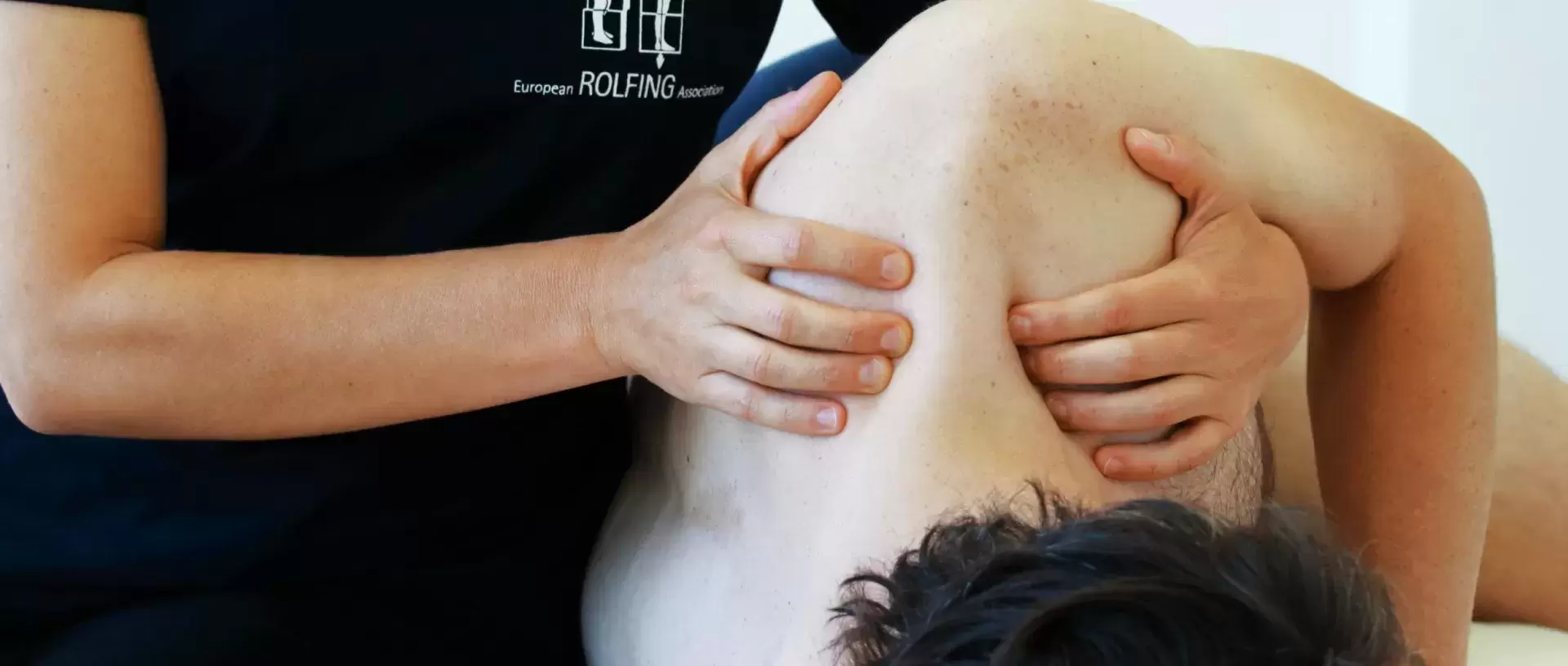Certified Rolfer® Course
• Received 3 movement sessions
• Attended 2 mentoring session
• Term Paper
• A 1-day first aid course (you can do this in your country with an accredited provider, eg the Red Cross)
• A basic criminal records check
See 'Who is this course for' for the full list of entry requirements.
Rita Geirola is a Certified Rolfer…
Gerhard Hesse is a Certified Advanced Rolfer…
Level 3 Rolfing® leads to a professional qualification as a Certified Rolfer® and membership of the ERA.
This classroom-based course lets you develop and deepen your Rolfing Structural Integration skills. Working with your own client, you’ll learn step-by-step how to put your skills into practice.
Level 3 Rolfing is taught over 10 to 12 months, in 7 modules of 4 to 7 days every 4 to 5 weeks.
There’s a personalised progress review and an exam in module 5, where your teachers will discuss your development with you to highlight areas where you might want to do extra work. For example, take an additional mentoring session or work through a personalised reading list.
The final interview at the end of module 7 will lead to the certification.
What to expect in class
In each module:
- you're taught using a mix of practical exercises and theory
- you’ll work in pairs or small groups to explore and practice the course content
- you’ll work one-to-one with your client
- you'll get plenty of support as there'll be one teacher for every 8 students and no more than 16 students per class
- there’ll be preparatory reading and homework between the modules
Certification
On successful completion of the course you'll graduate as a Certified Rolfer®. You’ll now join the European Rolfing® Association as a member and can open your own practice. As a graduate, you will qualify for two years of discounted membership fees
Module Dates:
- Module 1 – Mon 13 to Sun 19 Oct 2025 (Instructor: Rita Geirola)
- Module 2 – Thu 04 to Sun 07 Dec 2025 (Instructor: Gerhard Hesse)
- Module 3 – Thu 22 to Sun 25 Jan 2026 (Instructor: Rita Geirola)
- Module 4 – Thu 12 to Sun 15 Mar 2026 (Instructor: Rita Geirola)
- Module 5 – Wed 22 to Sun 26 Apr 2026 (Instructor: Rita Geirola)
- Module 6 – Thu 18 to Sun 21 Jun 2026 (Instructor: Rita Geirola)
- Module 7 – Thu 22 to Sun 26 Jul 2026 (Instructor: Rita Geirola)
Payment:
- Deposit - 1200 € (There will be no refund of the down payment if the training will not be finsihed.)
- Every Module (7x) - 1000 € each
(Prices, dates, course locations and teachers are subject to change.)
To be admitted to study, you need to fulfil the entry requirements. This helps us make sure that you are well prepared to follow the course content.
You need to have:
- a certificate of Level 2 Structural Fascial Bodywork or an equivalent certificate in Structural Integration from a qualifying school
- received 3 movement sessions from a Certified Rolf Movement practitioner
- attended 2 mentoring sessions by a registered mentor (you can do this local to you, find a Rolfing mentor near you)
- Term Paper ((Embodied experience of the Rolfing® Process and goals of the 10-session series, deadline 6 weeks after Level 2)
If you come from another qualifying SI-school (IASI approved), we’ll also ask you for:
- 10 serie Rolfing® sessions
- your Curriculum Vitae (CV)
- a 1-day first aid course (you can do this in your country with an accredited provider, eg the Red Cross)
- a basic criminal records check - contact us for details on how to do this in your country
- refined manual myofascial and neurofascial intervention skills, including deep ligamentous, visceral and cranial work
- testing and treatments for common structural pathologies
- the logic behind the ‘Ten Series’ based on its biomechanical and functional objectives
- how to recognise movement habits that can lead to structural lesions
- how to use active movement (Rolf Movement) as part of the Rolfing process
- listening and speaking skills that help you build a supportive therapeutic relationship with your client
- using touch to improve your client's movement coordination and self-regulation
- creating a safe environment in which your client can renegotiate their experiences, and nurture helpful movement patterns and behaviours
Dig deeper into the curriculum
Module 1 - functional embodiment of the ‘Ten Series’
This module focus on the functional and movement aspects of the ‘Ten Series’ of Rolfing sessions. You’ll deepen your understanding of the Rolfing process and learn how to offer movement explorations to your clients.
We will:
- revisit the functional objectives and implied biomechanical reality of each of the ten Rolfing Sessions
- review Rolf Movement™ strategies and application with a supporting and orienting touch
- work on our language skills to evoke intrinsic movement and reach deeper meaning for the client
- build a repertoire of embodiment exercises to support the goals of each session from a functional perspective
- set your client exercises as ‘homework’ to help them embody the results of the session
Module 2 - functional and dysfunctional aspects of specific anatomical structures
This modul will widen your appreciation for anatomy – we proceed from addressing basic anatomical topography to studying a selected number of anatomical systems and functional units and some of their potentially dysfunctional aspects.
We’ll focus on:
-
the development and role of connective tissue and its receptors, and how it organises the structure, function, coordination and orientation of the nervous system
-
functional and dysfunctional aspects of breathing, shoulders, hips and spinal organisation
-
the peritoneum as a relevant connective tissue structure and its role in movement
-
contraindications, post-surgical work and specific anatomical units that are of importance to appreciate Rolfing processes of differentiation and integration
Modules 3 to 7 look at the ‘Ten Series’ of Rolfing sessions in detail.
Module 3 - breathing freely in gravity, creating a lighter, lifted walk
In this module, we'll take a closer look at sessions 1 and 2 of the ‘Ten Series’.
We’ll focus on:
- understanding how the objectives of each session, your own limitations and the potential of your actions, will help you figure out where to focus your hands-on work with the client
- reviewing the biomechanics of breathing with related articulations and pressure system
- reviewing the biomechanics of walking, with special attention on feet, ankles and knee joints
- creating a safe environment for your client to sense and express freely what they are going through, and to feel heard, accompanied and respected
- learning to see and feel the unfolding of your client’s movement
Module 4 - easy sitting, easy standing, anchoring into the pelvic floor and feet
In this module, we'll take a closer look at sessions 3 and 4 of the ‘Ten Series’.
We’ll focus on:
- working with the lateral and inner lines of the body
- releasing tensions at the sides of the body to create differentiation between the front and back of the body
- achieving a first level of organisation for the shoulder and pelvic girdles, revealing new coordination possibilities for the arms and legs
- facilitating greater capacity for inversion and eversion in the feet
- restoring the balance of the adductors and abductors, and of the deep ligamentous structures in the pelvis
- restoring intra-pelvic movement, the physiological curves of the spine, and balancing diaphragmatic structures throughout the body
- using well-paced and thoughtful wording to accompany self-sensing and body image
Module 5 – freeing the midline of the legs – a strong, resilient, and supple back
In this module, we'll take a closer look at sessions 5 and 6 of the ‘Ten Series’.
We’ll focus on:
- working with the front and back lines of the organism – the content and container
- seeing and sensing as we work in deeper structures of the body
- freeing the diaphragm and crura, the sternopericardial ligaments, and the abdominal and thoracic organs to make more room for breathing and the psoas
- working on the articulations of the spine, ribs and sacrum, differentiating the role of the sacrum from the ilia in the dynamic of walking
- exploring a three-dimensional, listening touch that links visceral space to the activity of the intrinsic muscles
- using stimulating touch to explore the curves and bends of the spine
During this module your teachers will ask you to demonstrate your skills on session 5 and you will have a mid term interview for reflection.
Module 6 – a head fully supported from the ground and oriented in space
In this module, we'll take a closer look at sessions 7 and 8 of the ‘Ten Series’.
We’ll focus on:
- organising the lower body to increase support and the upper body for full expression
- organising the visceral space up to the neck and head, increasing the freedom of the jaw, differentiating the neurocranium and the viscerocranium, including several craniosacral techniques
- exploring areas where movement is inhibited and requires a listening and safe touch
- bringing your client’s awareness to how they use their senses (for example, more peripheral or focused vision)
- building your capacity to interact with your client’s perceptions and feelings, and helping them to understand their body image
- exploring guiding touch and movement to evoke support and orientation in your client, and to improve their awareness of their ‘pre-movement’ (unconscious movement strategies)
- learning how to improvise a strategy to address the particular needs of your client
Module 7 and certification workshop – integration and closure
In this module, we'll take a closer look at sessions 9 and 10 of the ‘Ten Series’.
We’ll focus on:
- integrating the trunk, spine and limbs
- thinking about ways that the body is both symmetrical and asymmetrical
- improving your ability to respond in an improvised way to your client’s needs
- learning to blend table work, chair work and standing work to evoke freer movement in your client
- exploring different kinds of contact and communication with clients
- exploring the deeper motivation of your client, working with them to identify what has been achieved over the course of the ‘Ten Series’, and what remains unresolved
- finding closure to enable new beginnings
This module ends with an final interview and the certification.









